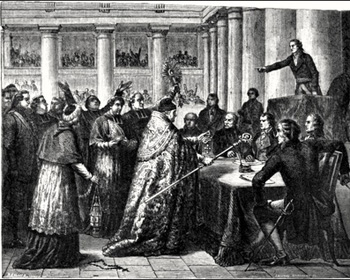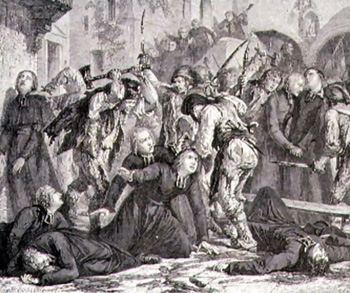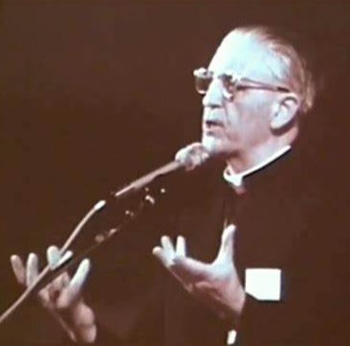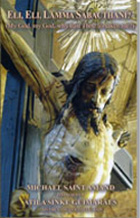Objections
Prove the Link between Vatican II &
the Civil Constitution of the Clergy
TIA responds:
M.B.,We thank you for your objection.
To see how the Civil Constitution of the Clergy is at the origin of Liberal Catholicism, Modernism and Progressivism, please read the article “Liberal, Modernists & Progressivists.”
For a summary on Vatican II and its endorsement of the French Revolution’s triad of Liberty, Equality and Fraternity, of which the Civil COnstitution of the Clergy is one of the most characteristic expressions, we recommend you to reading these articles here, here, here and here.
But, if you would like to have a complete overview on this topic, we first would invite you to read Mr. Guimarães’ 11-volume Collection on Vatican II, which exposes the whole progressivist agenda behind the documents, analyzing not only the letter of the documents, but more importantly their spirit.
You mention that Lumen gentium contains “truth twisted for ungodly agendas” – if you read Mr. Guimarães’ In the Murky Waters of Vatican II, you will learn that the documents skillfully employed ambiguous language in order to favor the progressivist current at the Council (“twisting the truth”). You can watch our video introduction/supplement to this Volume here.

Above, French clergy taking the oath the Civil Constitution of the Clergy; below, those who refused to take it were massacred

Regarding specifically the French Revolution, you should consider that Card. Suenens stated famously that “Vatican II was the [Revolution of] 1789 in the Church.” (see Volume IV, Animus Delendi I, Chapter I, p. 54, footnote 14). In the Collection (particularly Animus Delendi I and Animus Delendi II), we have noted the progressivists’ support of the French Revolution and its revolutionary triad Liberty, Equality, Fraternity (see particularly Animus Delendi I, Chapter IV,pp. 201-213), as well as the explicit support of the French Revolution by Vatican II documents (pp.213-217.).
On the progressivist plan to alter the structure of the Church, see Animus Delendi I, Chapter III, Item 2. b.
On the progressivists’ intent to democratize the Church, a principle on which the Civil Constitution is clearly based – in the text of the Civil Constitution of the Clergy (here), see all articles in Title II, Articles I, II, XXI; Title III, Article I – see Animus Delendi I, pp. 230-251, 307-338.
On the progressivists’ intent to destroy the monarchical character of the Church - which the Civil Constitution of the Clergy also sought to do by ordering the confiscation of properties as in Title I Article I, II, and XX, transforming the clergy into salaried “employees” of the State as in Title III, and the abolition of all episcopal and clerical posts in favor of the new as in Title I Article XX – see Animus Delendi I, pp. 163-171.
For the traditional teaching on the Pope as Monarch, see the same Animus Delendi I, pp. 259-271.
You asked specifically about Lumen gentium: to see some instances of how this important document plays into the progressivists’ plan to destroy the Church. We recommend you check Animus Delendi I, p. 54, footnote 14; pp. 71-72; p. 76; pp. 95-96; pp. 113-14 footnote 5. b.; p. 318, pp. 330-331.
It is important to remember that Pope Pius VI (1775-1799) condemned the French Revolution (see footnote 42 in the same Chapter IV of Animus Delendi I, pp. 202-204). He also condemned the Civil Constitution of the Clergy, which you can read on p. 307-310. A background (not without its revolutionary biases) on the Civil Constitution of the Clergy can be found here.

Card. Suenens:
‘Vatican II was the Revolution of 1789 in the Church’
Let us not forget also that a great part of the clergy just before and during the French Revolution was decadent and worldly. For instance, some Bishops preferred to be in the fashionable circles of Paris rather than in their own Dioceses. This was wrong on the part of the Bishops, since they should be in their Dioceses governing the faithful. Their action mirrored a similar phenomenon in the nobility: Louis XIV with his absolutism attracted the French nobles to join him in the court of Versailles, which was also wrong – a noble should mainly be in his region, ruling his people and ready to defend them with military force.
The enemies of the Church used this decadence in the clergy as well as the nobility as a cheap excuse to justify its anti-Catholic aims, which could never be justified.
In order to put History in perspective, we suggest you read Prof. Plinio’s landmark work, Revolution and Counter-Revolution (summaries here and here), to really understand history and how we have arrived at the crisis we are currently in. The book will help you establish some criteria to be able to discern where we were, where we are now, and where we are headed.
We hope this answers your question.
Cordially,
TIA correspondence desk

Posted July 26, 2022
______________________

______________________
______________________






















On your Instagram post, when you addressed the martyrdom of the Carmelites of Compiègne, you affirmed that the Civil Constitution of the Clergy issued by the French Revolution is a document similar to Vatican II.
Really? Where can I read that? Meaning, both documents side by side would be great evidence and support to what I’ve been telling people! The hardest is Lumen gentium, but I know for a fact that document is unholy and a truth that is twisted for ungodly agendas.
Regards,
M.B.